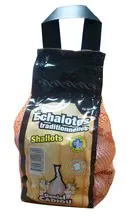 Production is less important than last year, which was exceptionally good in that regard. “We estimate that there is 20% less production in Brittany compared to a normal year,” explains Pierre Batardière, sales export specialist at Daniel Cadiou. This decrease in production is mainly due to a decrease in planting this year because the consequent yields from last year had led to lower shallot prices. But the weather conditions also played a role in the situation. “This year, planting took place very late because the beginning of the year was very humid which made it difficult to access the fields. Nevertheless, the cultivation was quite fast because once the planting was done around mid-April, we went from the ‘rainy season to the dry season’: we almost had a shortage of water. But in Brittany, these weather conditions did not have such a major impact as in other regions. The temperatures were not excessive and the generous sunshine helped us catch up, so although the caliber was smaller, the harvest took place almost on time.”
Production is less important than last year, which was exceptionally good in that regard. “We estimate that there is 20% less production in Brittany compared to a normal year,” explains Pierre Batardière, sales export specialist at Daniel Cadiou. This decrease in production is mainly due to a decrease in planting this year because the consequent yields from last year had led to lower shallot prices. But the weather conditions also played a role in the situation. “This year, planting took place very late because the beginning of the year was very humid which made it difficult to access the fields. Nevertheless, the cultivation was quite fast because once the planting was done around mid-April, we went from the ‘rainy season to the dry season’: we almost had a shortage of water. But in Brittany, these weather conditions did not have such a major impact as in other regions. The temperatures were not excessive and the generous sunshine helped us catch up, so although the caliber was smaller, the harvest took place almost on time.”
Despite the difficult weather conditions and the reduced yields, Pierre says that this season is much more promising than the previous one. “Already, the quality is generally good and demand is higher for the traditional shallot. The production last year was large in Brittany but also in all the other regions and countries producing these shallots, so export from Brittany was complicated. This year, it’s the opposite: in all those countries, new producers of this traditional shallot, yields are mediocre, or even catastrophic, because the cultivation conditions and the weather we experienced in Brittany were even worse in most other European regions. So we end up with a high demand on the market, which is much more promising than last year. The demand will now progressively increase as local productions will end. On the European scale, this shift should happen much earlier than last year.”
For more information:

Pierre Batardière
Sarl Daniel CADIOU
Manoir du Bant - 29440 Plouzévédé - FRANCE
Phone: +33 (0)2 98 69 99 17
Fax: +33 (0)2 98 69 96 04
Find Daniel CADIOU at Fruit Logistica - Hall 22 Stand D04
